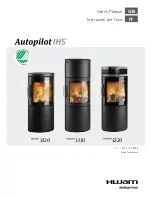
Page 12
125/150-SE-I01-210318
TYPES OF WOOD FOR FUEL
For best results use well-seasoned hardwood such as Oak, Ash or Beech. Allow wood to
dry out under cover in well-ventilated conditions for at least twelve months. As a rough
guide wood is ready for burning when radial cracks appear in the end of logs. Properly
dry wood means it should have a moisture content of between15%-20% which can only
be accurately measured using a moisture meter. Burning wood that is not seasoned will
result in tar being deposited in the stove, on the glass and in the flueways. This build-up
of tar is a hazard and if it ignites may cause a chimney fire. Resinous softwood burns
well and gives a high output for short periods but is not as efficient and does not last as
long as hardwood.
RE-FUELLING
Adding a 'little fuel often' is the best re-fuelling method to keep smoke to a minimum.
Our tests have shown that burning logs not longer than 20cm and with a width or
diameter of no more than 12cm will produce the optimum smoke free performance.
PEAT
Peat is a fuel conveniently available in some areas and should be burned in the same
manner as wood.
TECHNICAL INFORMATION
Normal heat output - wood
5.0kW
Weight of stove
83.6kg
Minimum chimney draught
10Pa
Mean flue gas temperature - Wood
229°C
Flue gas mass flow – Wood
3.1g/s
Summary of Contents for 150SE
Page 15: ...Page 15 125 150 SE I01 210318...


































